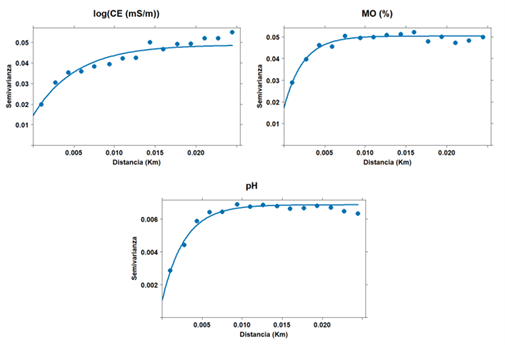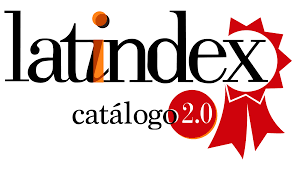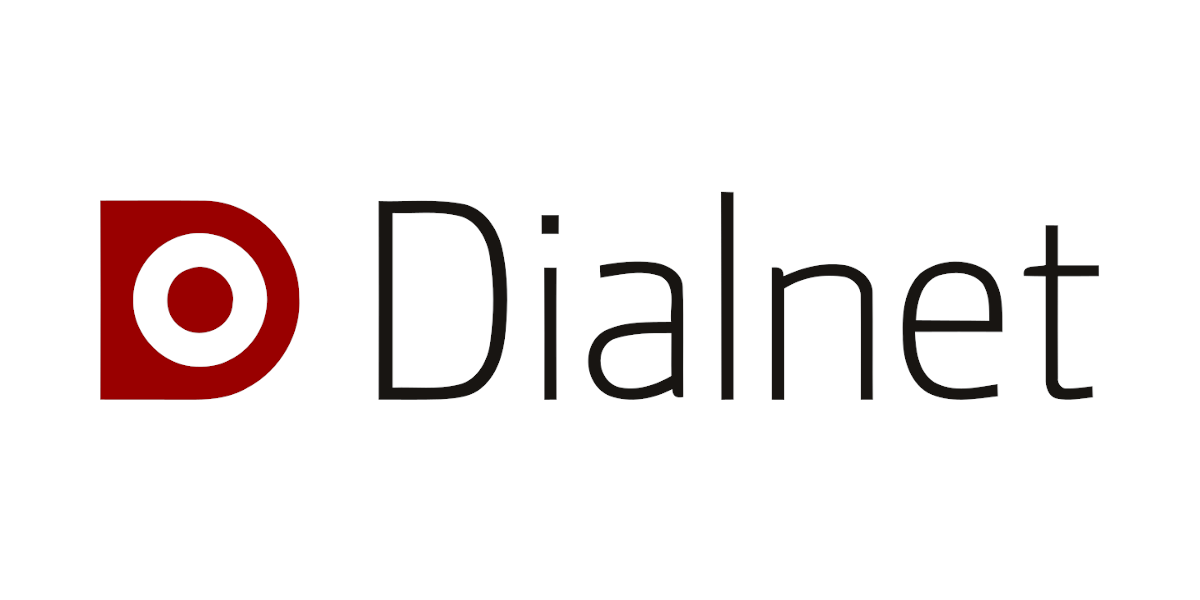Analysis of spatial variation in soil fertility for the delimitation of homogeneous management zones in precision agriculture
DOI:
https://doi.org/10.55996/dekamuagropec.v5i2.289Keywords:
Precision agriculture, principal component analysis, soil fertility, kriging, spatial variability, variogram, homogeneous management zonesAbstract
This study analyzed spatial soil fertility variability in a 1440 m² plot in Mosquera, Colombia, to create homogeneous management zones for precision agriculture. 480 soil samples were collected using a 3x1 m grid, analyzing pH, electrical conductivity, phosphorus, exchangeable cations, microelements, and soil organic matter (SOM). Principal Component Analysis (PCA) identified SOM, pH, and electrical conductivity as key indicators for zoning. Kriging interpolation mapped these properties, revealing high variability. The exponential model best represented the semivariograms. Fuzzy clustering, based on indicator thresholds, divided the plot into two zones, with high overlap between pH and SOM-based divisions. A QUEFTS model simulated crop yield, showing that optimized N and K fertilization, based on zoning, maximized yields. The study demonstrates the effectiveness of using PCA and Kriging to create management zones. SOM-based zoning improved P and K fertilization management, while pH-based zoning targeted micronutrient differences. The results highlight the potential of precision agriculture to improve crop yields and resource efficiency. Future research should incorporate physical soil properties and climatic variations for more comprehensive zone management.
Downloads
References
Ameer, S., Cheema, M. J. M., Khan, M. A., Amjad, M., Noor, M., & Wei, L. (2022). Delineation of nutrient management zones for precise fertilizer management in wheat crop using geo‐statistical techniques. Soil Use and Management, 38(3), 1430–1445. https://doi.org/10.1111/sum.12813
Bai, J., Wang, N., Hu, B., Feng, C., Wang, Y., Peng, J., & Shi, Z. (2023). Integrating multisource information to delineate oasis farmland salinity management zones in southern Xinjiang, China. Agricultural Water Management, 289, 108559. https://doi.org/10.1016/j.agwat.2023.108559
Bai, L., Zhang, Y., Wang, M., He, Y., Ye, T., & Zhao, K. (2022). Spatial Heterogeneity of Selected Soil Nutrients Related to Torreya grandis cv. Merrillii Plantation in Southeastern China. Phyton, 91(10), 2221–2233. https://doi.org/10.32604/phyton.2022.021422
Chen, W., & Liu, G. (2024). A Novel Method for Identifying Crops in Parcels Constrained by Environmental Factors Through the Integration of a Gaofen-2 High-Resolution Remote Sensing Image and Sentinel-2 Time Series. IEEE Journal of Selected Topics in Applied Earth Observations and Remote Sensing, 17, 450–463. https://doi.org/10.1109/JSTARS.2023.3329987
D’Acunto, L., Iglesias, M. A., Poggio, S. L., & Semmartin, M. (2024). Land cover, plant residue and soil microbes as drivers of soil functioning in temperate agricultural lands. A microcosm study. Applied Soil Ecology, 193, 105133. https://doi.org/10.1016/j.apsoil.2023.105133
Deng, X., Huang, Y., Yuan, W., Zhang, W., Ciais, P., Dong, W., Smith, P., & Qin, Z. (2023). Building soil to reduce climate change impacts on global crop yield. Science of The Total Environment, 903, 166711. https://doi.org/10.1016/j.scitotenv.2023.166711
Giordani, P., Ferraro, M. B., & Serafini, A. (2022). fclust: Fuzzy Clustering. In CRAN: Contributed Packages. https://doi.org/10.32614/CRAN.package.fclust
Gomez Sanchez, M. I. (2011). Guia de Recomendación y Manejo de Nutrientes Febrero-2011 | Fertilizante | Calcio. https://es.scribd.com/document/382579143/Guia-de-Recomendacion-y-Manejo-de-Nutrientes-Febrero-2011
Haroon, Z., Cheema, M. J. M., Saleem, S., Amin, M., Anjum, M. N., Tahir, M. N., Hussain, S., Zahid, U., & Khan, F. (2023). Potential of Precise Fertilization through Adoption of Management Zones Strategy to Enhance Wheat Production. Land, 12(3), 540. https://doi.org/10.3390/land12030540
Jing, Y., Bi, R., Sun, W., Zhu, H., Ding, H., & Jin, H. (2024). Whether Wheat–Maize Rotation Influenced Soil Organic Carbon Content in Sushui River Basin. Land, 13(6), 859. https://doi.org/10.3390/land13060859
Liu, W., Lu, F., Chen, G., Xu, X., & Yu, H. (2021). Site-specific management zones based on geostatistical and fuzzy clustering approach in a coastal reclaimed area of abandoned salt pan. Chilean Journal of Agricultural Research, 81(3), 420–433. https://doi.org/10.4067/S0718-58392021000300420
McCormick, S., Jordan, C., & Bailey, J. S. (2009). Within and between-field spatial variation in soil phosphorus in permanent grassland. Precision Agriculture, 10(3), 262–276. https://doi.org/10.1007/s11119-008-9099-4
Mondal, B. P., Sahoo, R. N., Bandyopadhyay, K. K., Das, B., Arora, A., & Mukherjee, J. (2022). Assessment of spatial variability of soil available sulphur using geostatistical techniques in a part of deccan plateau of India. Journal of the Indian Society of Soil Science, 70(2), 237–242. https://doi.org/10.5958/0974-0228.2022.00023.8
Nyengere, J., Okamoto, Y., Funakawa, S., & Shinjo, H. (2023). Analysis of spatial heterogeneity of soil physicochemical properties in northern Malawi. Geoderma Regional, 35, e00733. https://doi.org/10.1016/j.geodrs.2023.e00733
Pántano, V. C., Holzman, M. E., Penalba, O. C., & Rivas, R. (2022). ENSO Signal on Subseasonal Precipitation Distribution and Soil Moisture Response in the Argentine Pampas. Pure and Applied Geophysics, 179(2), 879–896. https://doi.org/10.1007/s00024-022-02949-6
Pizarro, S., Pricope, N. G., Figueroa, D., Carbajal, C., Quispe, M., Vera, J., Alejandro, L., Achallma, L., Gonzalez, I., Salazar, W., Loayza, H., Cruz, J., & Arbizu, C. I. (2023). Implementing Cloud Computing for the Digital Mapping of Agricultural Soil Properties from High Resolution UAV Multispectral Imagery. Remote Sensing, 15(12), 3203. https://doi.org/10.3390/rs15123203
Ramzan, S., Nazir, S., Ashraf, I., Wani, M. A., Wani, Z. M., & Shafiq, M. ul. (2021). Management zone delineation and spatial distribution of micronutrients in cold-arid region of India. Environmental Monitoring and Assessment, 193(7), 433. https://doi.org/10.1007/s10661-021-09216-6
Salem, H. M., Schott, L. R., Piaskowski, J., Chapagain, A., Yost, J. L., Brooks, E., Kahl, K., & Johnson-Maynard, J. (2024). Evaluating Intra-Field Spatial Variability for Nutrient Management Zone Delineation through Geospatial Techniques and Multivariate Analysis. Sustainability, 16(2), 645. https://doi.org/10.3390/su16020645
Sattari, S. Z., van Ittersum, M. K., Bouwman, A. F., Smit, A. L., & Janssen, B. H. (2014). Crop yield response to soil fertility and N, P, K inputs in different environments: Testing and improving the QUEFTS model. Field Crops Research, 157, 35–46. https://doi.org/10.1016/j.fcr.2013.12.005
Tokumoto, I., Inoue, K., Koga, N., Noguchi, T., & Ishikawa, Y. (2023). Recovery of a salinized tomato field in a coastal polder after the 2016 Kumamoto Earthquake in Japan. Smart Agricultural Technology, 5, 100287. https://doi.org/10.1016/j.atech.2023.100287
Vasu, D., Singh, S. K., Sahu, N., Tiwary, P., Chandran, P., Duraisami, V. P., Ramamurthy, V., Lalitha, M., & Kalaiselvi, B. (2017). Assessment of spatial variability of soil properties using geospatial techniques for farm level nutrient management. Soil and Tillage Research, 169, 25–34. https://doi.org/10.1016/j.still.2017.01.006
Wang, G., Cissé, G., & Staunton, S. (2024). Changes in chemical fractionation of copper and zinc in soil as a function of incubation moisture content and organic matter amendments. Chemosphere, 351, 141198. https://doi.org/10.1016/j.chemosphere.2024.141198
Wang, L., Guo, M., Chen, Z., Zhang, X., Zhou, P., Liu, X., Qi, J., Wan, Z., Xu, J., & Zhang, S. (2024). Quantifying the contributions of factors influencing the spatial heterogeneity of soil aggregate stability and erodibility in a Mollisol watershed. CATENA, 239, 107941. https://doi.org/10.1016/j.catena.2024.107941
Yadav, K. K., Mali, N. L., Kumar, S., Surya, J. N., Moharana, P. C., Nogiya, M., & Meena, R. L. (2022). Assessment of soil quality and spatial variability of soil properties using geo-spatial techniques in sub-humid southern plain of Rajasthan, India. Journal of the Indian Society of Soil Science, 70(1), 69–85. https://doi.org/10.5958/0974-0228.2022.00004.4
Yang, R., Harrison, M. T., & Wang, X. (2023). Current State and Limiting Factors of Wheat Yield at the Farm Level in Hubei Province. Agronomy, 13(8), 2043. https://doi.org/10.3390/agronomy13082043
Yao Wang, Aurangzeib, M., & Zhang, S. (2022). Topography and Land Management Change the Heterogeneity of Soil Available Nitrogen in a Mollisol Watershed of Northeastern China. Eurasian Soil Science, 55(2), 200–211. https://doi.org/10.1134/S1064229322020132

Downloads
Published
How to Cite
Issue
Section
License
Copyright (c) 2024 Julio Galindo-Pacheco, Ruy Vargas-Díaz, Carlos Martínez-Niño, Clara Franco-Florez

This work is licensed under a Creative Commons Attribution 4.0 International License.
Los autores que publican en esta revista aceptan los siguientes términos:
- Los autores conservan los derechos de autor y conceden a la revista el derecho publicación con la obra, simultáneamente licenciada bajo una licencia de Creative Commons CC By que permite a otros compartir el trabajo, pero citando la publicación inicial en esta revista.
- Los autores pueden celebrar acuerdos contractuales adicionales separados para la distribución no exclusiva de la versión publicada de la obra de la revista (por ejemplo, publicarla en un repositorio institucional o publicarla en un libro), pero citando la publicación inicial en esta revista.
- Se permite y anima a los autores a publicar su trabajo en línea (por ejemplo, en repositorios institucionales o en su sitio web) antes y durante el proceso de presentación, ya que puede conducir a intercambios productivos, así como una mayor citación del trabajo publicado (https://web-archive.southampton.ac.uk/opcit.eprints.org/oacitation-biblio.html)














